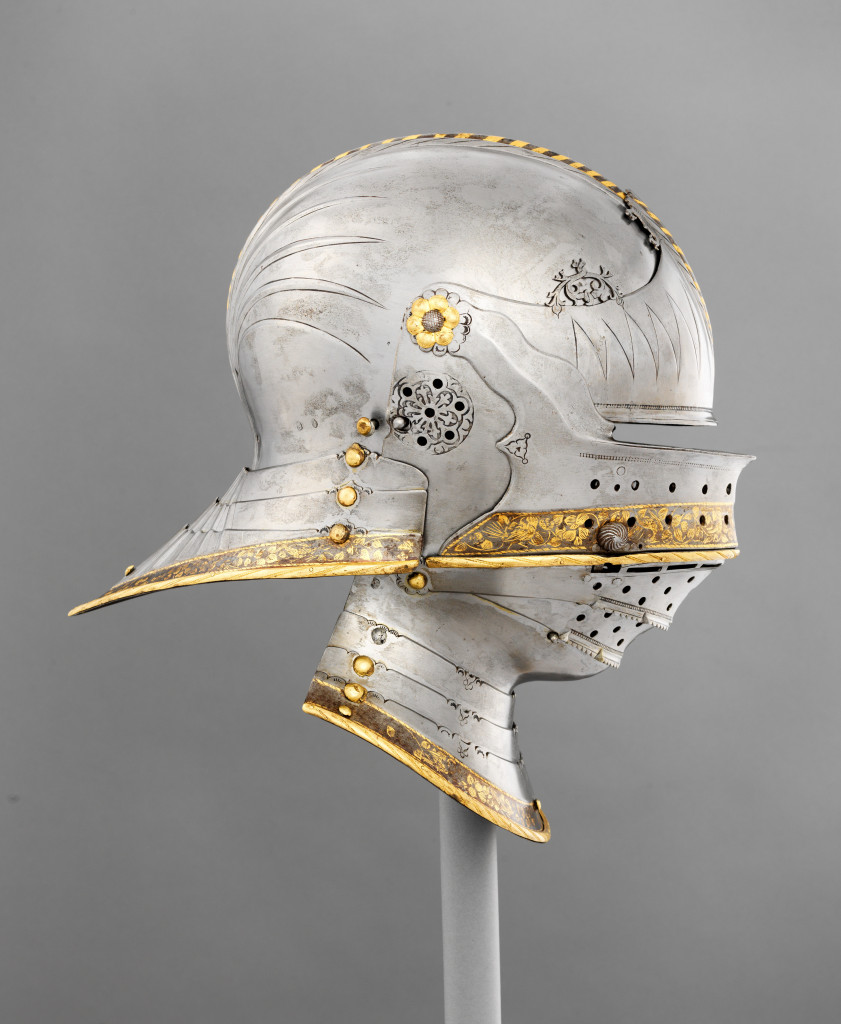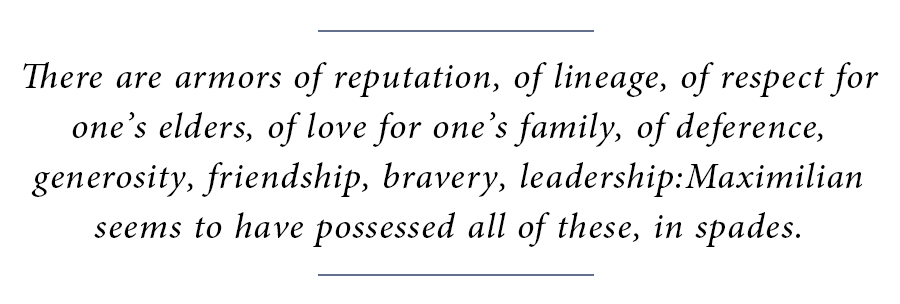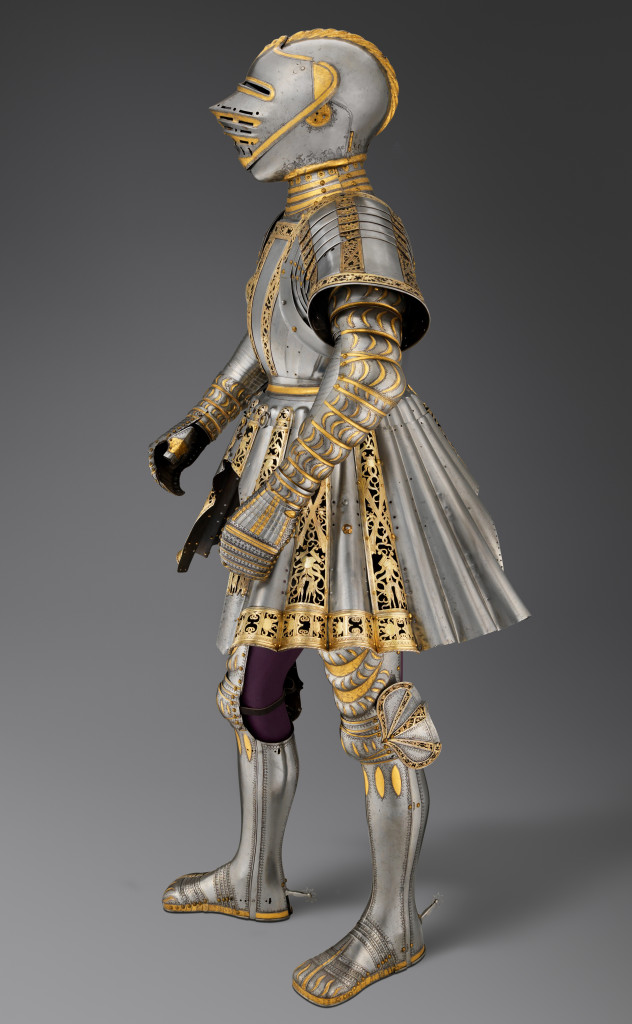The Last Knight the Art Armor and Ambition of Maximilian I

Combination Sallet and Bevor of Maximilian I by Lorenz Helmschmid (first recorded 1467, died 1516), High german (Augsburg), circa 1495. Steel, leather, copper alloy, and gold; 15 by 13-5/8 by eight-15/sixteen inches. Kunsthistorisches Museum, Vienna, Purple Armoury (A 110 1). Photo credit: Bruce M. White, 2019.
By James Balestrieri
NEW YORK CITY – The Duchies of Burgundy and the Low Countries. The Kingdom of Bohemia. The Republic of Venice. Brabant. Flanders. The Holy Roman Empire. Names of places absorbed into history and geography classes, the lines that defined them erased from maps, they are as far from us as the world of armored knights, tapestried courts, knightly and jousts, shifting alliances and expedient betrayals that sustained them for centuries. Merely that globe, the world of the knights, maintains its grip on our imaginations. "The Last Knight: The Fine art, Armor and Ambition of Maximilian I," now on view at the Metropolitan Museum of Fine art, suggests that rulers similar Maximilian labored long and difficult to ensure that their legacies – and legends – would live on after them, reverberating downwardly the centuries. The mirror gleam of their armor, symbol of ability and prestige in their lifetimes, survives equally a looking glass that takes us back to their world – as it was, and as they wanted us to see it.
I still have my Britains Ltd knights. Toy soldiers to well-nigh; armed services miniatures to the serious. No, sadly, they're non mint in the box. They are veterans of many campaigns, sieges, tournaments. My kids played with them – and others, new ones, that came at Christmas and on birthdays. I made them a giant castle out of the styrofoam inserts that act as armor for computers, lamps and dishes when they're shipped. They introduced dragons – naturally – dinosaurs and pirates into the worlds they created, swaddling the knights in the impossibilities that are the very stuff of thousands of books and films. How many times, heading to the Met, did I ransom them – so they would endure through exhibitions I dragged them at that place to see – with the hope to stop the day in the Arms and Armor wing?
Maximilian certainly played with toy knights and gave them as gifts. Two can be institute in the groundwork of a woodcut by Hans Burgkmair in an unpublished 1515 epic titled the Weisskunig (The White King), commissioned and overseen by Maximilian. "Intended to be an autobiography," the catalog states. "it [the Weisskunig] fictionalizes the characters and takes on the nature of an allegory. The various kings, for example, are designated by colors, based on their heraldry. The White, or "Wise," King (the pun is close in German) represents Maximilian in a color that denotes purity; his father, Frederick Iii, is chosen the Sometime White King. His nemesis, the French monarch, is the Blue King; Republic of hungary, the Green King; and Venice (in reality, a kingless republic), the Fish King." In the Weisskunig, dynastic politics becomes a sophisticated board game, multidimensional chess presented in graphic novel form.
 Several bodily toy knights – rare survivors, peradventure commissioned for Maximilian's grandsons, made of bronze – can be seen in the exhibition. "Each of these toys has a horse mounted onto a base plate with functioning spoked wheels and a rider riveted to a saddle assuasive it to tilt backward when struck by an opponent's lance." From these early on incarnations of "Rock Em, Sock Em Robots," Maximilian extrapolated what came to exist called Jousts of Peace, light armored contests with blunted lances and bound loaded shields he helped design. Alongside these, tournaments featured trigger-happy, sometimes mortiferous Jousts of War, with and without tilts – the fences that separate contestants – as well as complimentary tourneys and episodes of pes combat. Each had dissimilar rules and required different armor, weaponry and tactics. Toys imitate, prefigure and prepare the young for tournaments; tournaments imitate, prefigure and prepare young knights for state of war. Play and war. State of war and play.
Several bodily toy knights – rare survivors, peradventure commissioned for Maximilian's grandsons, made of bronze – can be seen in the exhibition. "Each of these toys has a horse mounted onto a base plate with functioning spoked wheels and a rider riveted to a saddle assuasive it to tilt backward when struck by an opponent's lance." From these early on incarnations of "Rock Em, Sock Em Robots," Maximilian extrapolated what came to exist called Jousts of Peace, light armored contests with blunted lances and bound loaded shields he helped design. Alongside these, tournaments featured trigger-happy, sometimes mortiferous Jousts of War, with and without tilts – the fences that separate contestants – as well as complimentary tourneys and episodes of pes combat. Each had dissimilar rules and required different armor, weaponry and tactics. Toys imitate, prefigure and prepare the young for tournaments; tournaments imitate, prefigure and prepare young knights for state of war. Play and war. State of war and play.
Who was Maximilian? Born in Vienna in 1459 to Emperor Frederick 3 and Eleanor of Portugal, the Holy Roman Empire that had begun with Charlemagne in 800 had become a network of political islands, each with its own local rulers and laws, over which the emperor had little if any bodily dominance. Maximilian came into his title with no administrative experience and picayune coin of his own. His isn't quite a rags to riches story, but in terms of the world of the knights, it's close. His father did brand a skilful match for him, with Mary of Burgundy. Their marriage appears to have been much more than an expedient arrangement and her war chest got Maximilian off to a practiced commencement, expanding his brand and ability right abroad. Fighting at the front of his knights; jousting and fighting in tournaments; designing armor, giving armor away, commissioning epic poems and manuals of arms starring thinly veiled versions of himself, Maximilian spent his reign attempting to make a movie out of the empire's disparate puzzle pieces, pieces scattered from the north of Germany to Italy and from French republic to the Eastern edge of Eastern Europe.
The Last Knight. Merely the romance of the sound of it makes you think it has to exist some sort of fictional construct, a legend, a story passed downwards in a Game of Thrones game of telephone. And it is. Ii examples will suffice. Maximilian recognized the genius of Albrecht Durer and enlisted him to design a monumental arch that would become a print composed of 36 folio-sized sheets requiring 195 different woodblocks. The print, a portable Arch of Constantine or Arc de Triomphe, stands 11 anxiety tall. Three portals – Honor and Ability, Nobility and Praise – connect the emperor to Rome, to his ancestors and to his allies. His ain deeds weave through the complex, emblematic iconography, rising to a mysterium, in which "hieroglyphic animals that environment Maximilian form a rebus that express the ideas communicated throughout the work regarding the emperor'southward aboriginal lineage, courage, ability and desire for lasting fame." Then, consider the painted sandstone reliefs that adorned the Golden Roof, an ornate loggia overlooking a square in Innsbruck, Austria, where Maximilian and his family unit could detect tournaments, pageants and ceremonies in the square beneath. In these reliefs, among the coats of arms and contorted dancers, Maximilian himself appears, with Mary of Burgundy, who passed away in 1482, and with his second wife, Bianca Maria Sforza, who became his wife in 1494. Similar Mary, she brought a sizable dowry and furthered Maximilian's aims in Italy. Like Mary, Maximilian seems genuinely to have cared for her. But in the reliefs, they appear as if they are there, watching some spectacle below. Maximilian asserts his presence even when he is non physically at that place.
Evolution selected human beings to have no armor, no beat nor carapace nor exoskeleton; we are not lobsters, tortoises, beetles or ankylosaurs. We are made to be quick and calorie-free. Early, though, once we learned to smelt and shape metal, we fashioned information technology for offense and defense force. We fabricated projectile points and swords, merely also metallic shields and suits. We made metal suit us – so adorned it.
There are many orders of armor, and Maximilian fabricated sure his were in perfect order. In that location are armors of reputation, of lineage, of respect for one's elders, of honey for one's family, of deference, generosity, friendship, bravery, leadership: Maximilian seems to accept possessed all of these, in spades. Because of him, Hapsburg blood ran through Spain, Italy, France, England, Russian federation and all of Eastern Europe and the Low Countries for centuries. As the Holy Roman Empire shifted and transformed into what became the Austro-Hungarian Empire – whose last ruin and dissolution would come afterwards defeat in Earth War I – the Hapsburg line ruled. But as he had splendid suits of armor made for disparate roles, he also had himself painted on his deathbed as a wizened, mortal man who had given his all for God and had his body flayed to testify his humility and bloodshed, even as his divinity as a monarch lived on.

Ceremonial Armor of Charles V past Conrad Seusenhofer (first recorded 1500, died 1517), Austrian (Innsbruck) and High german (Augsburg), circa 1512-fourteen. Steel, silver, aureate, copper alloy, fabric, and leather; equally mounted: 58-5/eight by 27½ by 21-5/8 inches. Kunsthistorisches Museum, Vienna, Imperial Armoury (A 109). Photo credit: Bruce M. White, 2019.
Perhaps the most honest object in the exhibition is the Sword of Maximilian. Despite the symbols that cover information technology, especially the "burn down steels, flaming flints and the raguly crosses of Saint Andrew, all of which are badges of the Burgundian Order of the Gilt Fleece," a gild of monarchs and nobles that Maximilian revived, led and sought to fashion into a Sixteenth Century version of NATO, this sword'south "deep cuts and nicks on the edges of the guard that face the point of the blade prove that the weapon saw active service in gainsay… Although the majority of his surviving armors were designed for tournaments, this sword is among the few extant battle swords known to take belonged to him."
H.G. Wells was a toy soldier enthusiast who devised games and wrote two books on carpet battles. A committed pacifist, he saw no contradiction between his beliefs and his love of toy soldiers. Written just as Globe State of war I – the Smashing War – was grinding men in trenches and bringing the Hapsburg line to its end, Wells wrote in a book chosen Little Wars: "Yous have only to play at Piffling Wars 3 or four times to realise just what a blundering thing Great War must be. Dandy War is at nowadays, I am convinced, not but the most expensive game in the universe, but information technology is a game out of all proportion. Not only are the masses of men and cloth and suffering and inconvenience likewise monstrously big for reason, simply – the available heads we take for information technology, are too small. That, I think, is the virtually pacific realisation conceivable, and Little War brings y'all to it equally zilch else but Peachy State of war can do."
Here's the indicate. All mythmaking bated, Maximilian seems to have gone to great lengths to avoid war whenever he could. Not only did he know defeat, he knew that – win or lose – war exacted a heavy toll. Perchance the toys and tournaments helped him meet this and negotiate wherever he could while projecting an image of invincibility. Hard to say, but worth thinking about.
In my house, we've played them all: Stratego, Axis and Allies, Dragonwood – a new game – and sturdy one-time Battleship. Once in awhile the knights and castle come up out – or possibly the armies of the American Revolution, or the Napoleonic Era. Nosotros gyre die sometimes, following rules or making them up, knocking the poor chaps over before removing them from play. Simply sometimes we just spend the afternoon setting everything up: terrain, buildings, hills, forests, regiments of cavalry and infantry and merely leave information technology and look at it, taking in the diorama suspended at that place on the dining room table or floor in our moment of creativity. I can imagine Maximilian surveying the field in the all the same silence before the armies began to clash. Information technology's the same feeling I go looking at a suit of empty armor on a museum mannequin, imagining who made it, who wore it – and why – a suit that I am happy to find empty, devoid of its sanguine utility, transformed by time from state of war into art.
The exhibition will go on through Jan 5, 2020 at the Met Fifth Avenue, located at 1000 5th Avenue. For more data, www.metmuseum.org or 212-535-7710.
mcintyrehingivend40.blogspot.com
Source: https://www.antiquesandthearts.com/the-last-knight-the-art-armor-and-ambition-of-maximilian-i/
ارسال یک نظر for "The Last Knight the Art Armor and Ambition of Maximilian I"